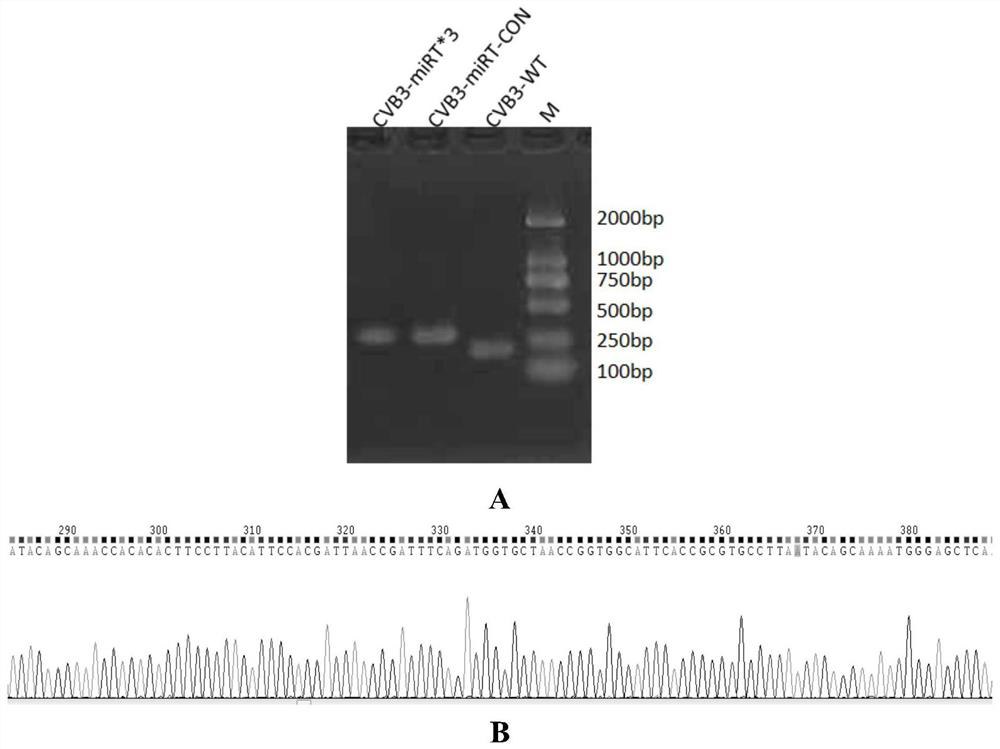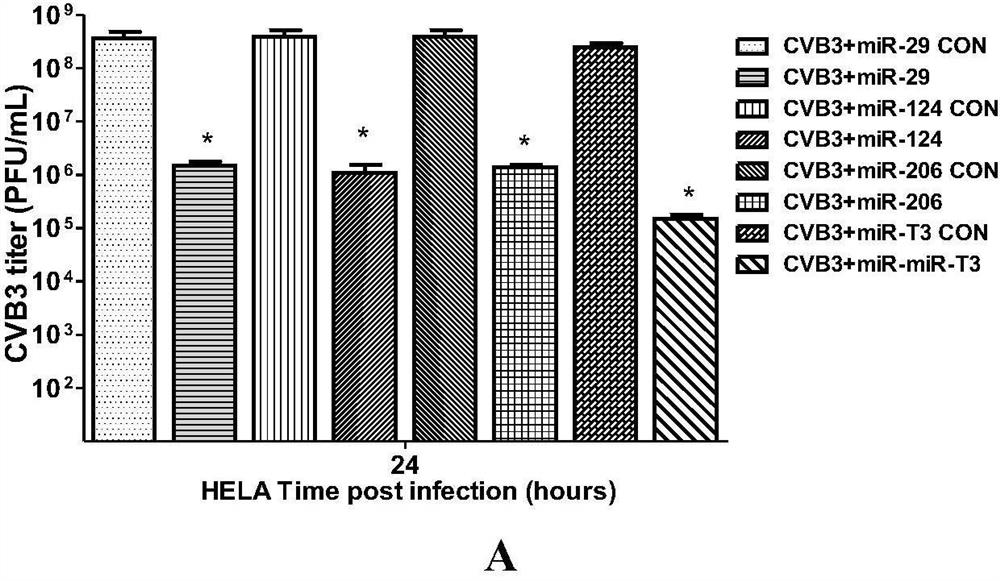Multi-tissue restriction type coxsackie group B type III virus inserted with miRNA complementary sequence and application thereof
A technology of complementary sequence and insertion sequence, which is applied in the field of medicine and biology, can solve the problems of virus replication, damage to the body, and reduction, and achieve the effect of avoiding fatal damage and reducing recovery pressure
- Summary
- Abstract
- Description
- Claims
- Application Information
AI Technical Summary
Problems solved by technology
Method used
Image
Examples
Embodiment 1
[0042] Example 1. Construction of CVB-miRT*3.
[0043] 1. The source and sequence structure of CVB3-WT strain
[0044] The virus used in the present invention is CVB3m strain (GenBank: M33854.1).
[0045] 2. CVB-miRT*3 insertion sequence (complementary sequence structure of 3 miRNAs), insertion position, construction method
[0046] The plasmid carrying the sequence of CVB3m strain was constructed by reverse genetics method. According to the tissue specificity of microRNA, we selected miR-206, miRNA-29a-3p, and miRNA-124-3p with muscle, pancreas, and brain tissue specificity. According to databases and literature reports, the sequences of these three miRNAs are completely consistent between humans and mice. Mature miRNAs with core sequences were selected in the miRbase database.
[0047]
[0048]
[0049] A synthetic insert sequence was constructed, as shown in SEQ ID NO.1 below:
[0050] 5'CCACACACTTCCTTACATTCCACGATTAACCGATTTCAGATGGTGCTAACCGGTGGCATTCACCGCGTGCCTTA ...
Embodiment 2
[0055] Example 2. Functional verification of CVB-miRT*3 by in vitro experiments
[0056] Firstly, the transfection of the modified plasmid and the quantitative experiment of virus production were carried out, and the amount of virus produced at different time points after transfection with different concentrations of plasmids was measured by using the plaque formation experiment. The quantification curve was made according to the calculation of PFU / ml, which became the key point of this experiment. Positive quality control.
[0057] Synthesize miRNA-206, miRNA-29a-3p, miRNA-124-3p in vitro, observe the effect and dose-effect relationship of exogenous miRNA on CVB-miRT*3 specificity in HeLa cells: set the concentration of 100nM to synthesize the above miRNA and the corresponding control miRNAcon were transfected into HeLa cells separately or mixed, and the miRNA-con control transfection group was set at the same time. After 4 hours, CVB-miRT*3 was applied, MOI=1.0, and the prot...
Embodiment 3
[0065] Example 3. Functional verification of CVB-miRT*3 by in vivo experiments
[0066] 6-8 week-old BALB / c male mice (18-22 g) were to be purchased from the Institute of Experimental Animals, Chinese Academy of Medical Sciences. (The animal experiment protocol passed the animal ethics review of the Capital Institute of Pediatrics). The mice were randomly divided into 4 groups with 15 mice in each group.
[0067] (1) To assess the virulence of the virus in combination with the death rate of the animals after inoculation:
[0068] Press 1*10 4 , 1*10 5 , 1*10 6 , 1*10 7 , 1*10 8 , 1*10 9 Virus titer of PFU / mouse The mice were inoculated intraperitoneally, and the median lethal dose (LD50) of the virus to mice was calculated according to the method of Reed-Muench.
[0069] (2) Assess the pathogenic pathology of modified CVB3:
[0070] ① Mice were grouped and intraperitoneally injected according to the above, and the inoculation amount was the half-lethal dose (LD50) of ...
PUM
 Login to View More
Login to View More Abstract
Description
Claims
Application Information
 Login to View More
Login to View More - R&D Engineer
- R&D Manager
- IP Professional
- Industry Leading Data Capabilities
- Powerful AI technology
- Patent DNA Extraction
Browse by: Latest US Patents, China's latest patents, Technical Efficacy Thesaurus, Application Domain, Technology Topic, Popular Technical Reports.
© 2024 PatSnap. All rights reserved.Legal|Privacy policy|Modern Slavery Act Transparency Statement|Sitemap|About US| Contact US: help@patsnap.com










